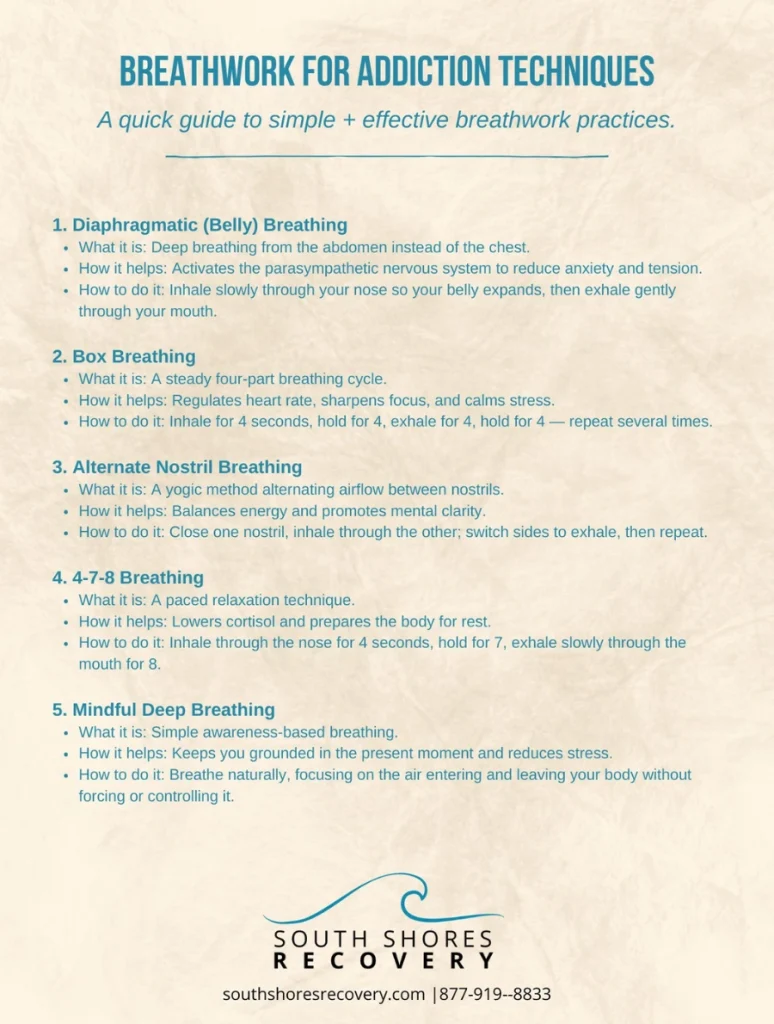Deep Breathing and Using Breathwork to Support Sobriety Success
You might think that breathwork and breathing exercises are not a proven way to reduce stress and overcome cravings and other challenges in sobriety. The truth is they are both amazingly effective.
Using breathwork for addiction recovery is an evidence-based technique. It supports people in regaining balance, reducing stress, and reclaiming their well-being after substance abuse. And controlled breathing techniques provide holistic healing when integrated with addressing the mental health aspects of substance use disorders in therapy.
At South Shores Recovery in Dana Point, California, our clinical staff uses breathwork therapy at many points throughout the recovery process. Our clients have found it helpful for everything from managing cravings to calming emotional distress. When we tell our clients to take a few deep breaths, we mean it literally.
Our resource will provide details on how simple, intentional breathing techniques helps clients calm the sympathetic nervous system, manage stress, and experience improved focus and clarity more quickly.
How Does Breathwork Therapy Support Addiction Recovery?

In many cases, people struggle with substance use disorders because they have learned to use alcohol or drugs as a coping tool instead of learning healthy ways to deal with stressful moments or underlying triggers in everyday life.
When we teach clients to learn controlled, slow breathing, they experience less tension and gain emotional regulation. The effective breathwork techniques they master in therapy become tools they use in their long-term recovery efforts.
Breathing Therapy and Breathwork as Supportive Recovery Tools
Using breathwork for addiction recovery supports the physical health and psychological aspects of healing.
Controlled breathing techniques engage the parasympathetic nervous system, which help the body exit the fight-or-flight response after a moment of fear or anxiety has passed.
When clients learn to slow down and exhale slowly, they learn how to release tension and slow their heart rates. They also learn to calm themselves down in stressful situations. Breathwork is a healthy coping mechanism that connects the mind and the body for a better sense of inner peace.
The Science Behind Deep Breathing and Finding Emotional Balance

Many studies have found that deep breathing techniques lower cortisol levels and support parasympathetic nervous system health. Replacing shallow breathing with taking deeper, more controlled breaths allows the body to rest and reset. As oxygen flow increases, clients report feeling clear-headed and anchored in the present moment.
Breathwork therapy teaches that focusing on the moment slows the stress response. It empowers people to make more conscious choices and improve their overall well-being.
There are many types of breathwork that work in a recovery setting, too many to cover in one post. However, the resource below tells you a little more about five of our favorites:
10 Benefits of Breathing Techniques to Reduce Cravings and Provide Stress Relief

Breathwork is one of the most accessible tools available for managing stress levels and emotions. With regular practice, it can support emotional resilience and create a brief pause for reflection before responding to a stressful event or a triggering person.
Some clients find that adding structured breathing exercises to their recovery routine makes all the difference when cravings arise. The increased self-awareness allows them to observe their cravings and sit with them until they pass.
1 – Diaphragmatic Breathing Can Help Restore Control
Diaphragmatic breathing, also known as belly breathing, exercises expand the abdomen rather than the chest. The technique can increase oxygen flow and help calm the sympathetic nervous system. It can be invaluable as a method that will ease withdrawal symptoms or reduce anxiety.
Belly Breathing Exercises and Your Daily Recovery Plan
Belly breathing takes a little bit of practice, but the results are well worth the effort. It supports steady oxygen intake and relieves muscle tension, which sometimes accompanies early recovery. The technique also helps release stress and keep you grounded.
Belly breathing can also help you manage stress in everyday life without relapse. The technique will feel awkward at first, but you will be thankful for the tool once you have mastered it.
2 – Box Breathing for Anxiety and Focus
Box breathing follows a steady, comforting rhythm of equal counts: inhale, hold, exhale, hold. The method is easy to remember, quick, and ideal for stress management.
When you practice it several times a day, you can regain control over your anxiety and clear mental fog, which is common in the earliest days of recovery.
3 – How Alternate Nostril Breathing Promotes Relaxation
Alternate nostril breathing exercises come from traditional yoga. Yogis believe that it balances the energy flow across both sides of the body, thus regulating the nervous system.
It’s a case where combining breathwork with meditation, yoga, or other various techniques to treat addiction holistically.
4 – Breathwork Techniques to Manage Triggers and Urges

The most effective breathwork techniques can help with managing urges to use again. Learning to pause and focus can help you quiet racing thoughts and emotional turmoil, helping you resist the urge.
Making deep breathing exercises part of your daily routine enhances self-awareness and builds confidence when it’s time to face the challenges of ongoing, lasting recovery.
5 – Breathwork Practices Improve Sleep and Mental Clarity
Many clients report that breathwork enhances sleep quality and improves mental focus during the day. it is a great addition to a healthy bedtime routine.
Slowing your breath before going to bed helps your body transition into a state of relaxation, making it better prepared for a restful sleep. The oxygen helps regulate energy and mood as you drift away into a restful slumber.
6 – Breathwork Therapy Complements Counseling and Detox
Breathwork therapy works seamlessly in counseling and detox programs. Proper breathing helps clients manage withdrawal symptoms and cravings, reduce stress and anxiety, and increase oxygen flow throughout the body.
Our counselors at South Shores often use breathwork for addiction treatments, including support group sessions, individual therapy, and during emotional releases.
7- Building Emotional Awareness Through Deep Breathing
Deep breathing sessions can release spiritual blocks, an important aspect that may hold clients back from healing. Addressing those blocks can enhance emotional stability and awareness in a safe and controlled setting.
Breathwork assists people as they get in touch with their emotions, examine them, and promote healing from within.
8 – Breathwork and Mindfulness in Addiction Treatment

Breathwork complements mindfulness and meditation effectively in addiction recovery programs. The two practices reinforce one another.
Mindfulness supports greater self-awareness; breathwork allows the person to remain present in the moment. Combined, they help reduce anxiety and stress.
9 – Practicing Breathwork in Addiction Recovery Programs
Holistic addiction recovery programs recognize how breathwork helps regulate mood and enhances emotional self-control.
Whether clients prefer 4-7-8 breathing, box breathing, or holotropic breathwork, the goal is always to help clients stay grounded, stress-free, and committed to ongoing recovery.
10 – Deep Breathing Supports Physical Health and Boosts Energy
Breathwork is best known for its mental health and emotional benefits, but it also has a positive impact on physical health. Addiction is not only harmful to our mental well-being; the body also suffers from neglect during substance abuse.
The deep breathing cycles of breathwork for addiction improve circulation, lower blood pressure, and help the body process toxins more efficiently by oxygenating the bloodstream. After a short time, the increase in oxygen can increase stamina, support healthier muscles and tissue, and help you make healthier decisions.
Some clients notice significant increases in natural energy and better moods. Others express that they feel fewer physical aches and pains when they’ve made breathing part of their daily recovery routine.
Our Favorite Tips for Creating a Daily Breathwork Routine at Home

The best thing about a breathwork routine is that you don’t need any special equipment or even much experience in the techniques. What matters is your intent and consistency.
Here are some tips to help you get started on a breathwork routine:
- Set a short amount of time aside each day for deep breathing. Start small, even five minutes can be helpful. Mornings are good for many, when the mind is clear. Deep breathing helps you set a positive tone for the day. On the other hand, some prefer breathwork in the evening to release tension or stress. Either way – or both – is fine; do whatever you will stick with.
- Set reminders until breathwork becomes part of your daily routine. Recovery means retraining your mind and body, and setting reminders can help you stay on track. Set an alarm on your phone or Alexa entitled, “Breathe.” The alert will tell you it’s time to take that much-deserved break and take time for deep breathing.
- Add breathwork to your aftercare plan. The cravings arise even after you leave the safety of a recovery center. But taking a slow, deep breath or two can help you engage the parasympathetic nervous system and lower your stress when those cravings hit. In this moment, you start to regain control and avoid slip-ups.
- Keep track of your progress. Make a note in your phone or journal about how you feel after each breathing sessions. Over time, you will see patterns that change – better emotional stability, less stress, clearer thinking. Tracking the changes can be very motivating!
- Find what you enjoy and keep it simple. There are many breathing techniques – find a few to try on YouTube. When you find one you enjoy, stick with it, and learn how to do it correctly. You don’t need to master multiple techniques at one time.
Call South Shores Today to Begin Your Addiction Recovery Journey
When you are ready to commit to getting clean and sober, South Shores Recovery is here to support you. We will help you at every step along the way, from getting your insurance benefits approved to program graduation and complete aftercare and relapse prevention planning.
Our professionals stay at your side and will work tirelessly to help you reach your recovery goals.
Call us today for information about our recovery programs; it’s free and always confidential to speak with our team, so please make the call now.


Recent Comments